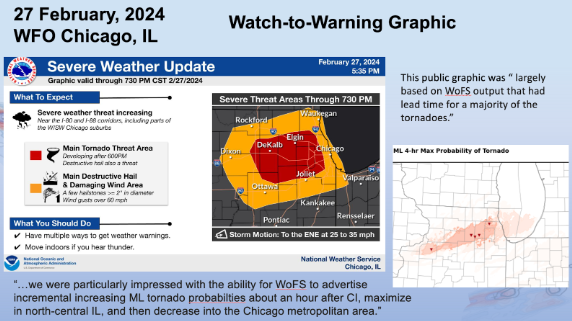The Joint Technology Transfer Initiative supported the development and completion of the “WoFS ML Severe” severe weather probability suite, which is based on the Warn-on-Forecast System and machine learning. WoFS ML Severe uses inputs from the Warn-on-Forecast System and is trained on a combination of local storm reports and radar-based detections of severe weather to produce skillful forecasts of the probability that a given thunderstorm will produce large hail, damaging winds, or a tornado.
WoFS ML Severe presents the individual hazard probabilities separately; combined as the probability of any severe weather; or even the probability of high-end or “significant” severe weather, using thresholds defined by the Storm Prediction Center. These forecasts project out to four hours and can be examined in 30-minute increments to focus on areas of immediate concern.
The WoFS ML Severe suite of products has been shared with National Weather Service local and national forecasters through testbed activities, online tutorials, and in-person workshop presentations to NWS Science & Operations Officers. In a 2024 survey of long-time Warn-on-Forecast users, WoFS ML Severe emerged as the most popular product for obtaining a quick overview of the severe weather potential when a new WoFS run arrives (every 30 minutes).
There are also cases in which WoFS ML Severe directly contributed to real-time local severe weather messaging. On February 27, 2024, NWS Chicago was dealing with developing thunderstorms in an environment where severe weather was possible, including tornadoes. Forecasters used WoFS ML Severe to produce public forecasts that confidently predicted that the risk of tornadoes would maximize just west of Chicago and decrease as the storms entered the city. As Brett Borchardt of NWS Chicago notes, “We were particularly impressed with the ability for WoFS to advertise incremental increasing ML tornado probabilities about an hour after [thunderstorms began], maximize in north-central Illinois, and then decrease into the Chicago metropolitan area. This is almost exactly what occurred!”
The WoFS Transition Plan notes in a milestone that “the WoFS ML Severe suite is a baseline component of WoFS,” meaning it will transition to operations along with the modeling system. This research-to-operations success story was made possible, in part, by support from JTTI.

This testimonial was written by Montgomery Flora, the lead PI for the project “Probabilistic Prediction of Thunderstorm Hazards using the NOAA Warn-on-Forecast System and Machine Learning,” awarded in the JTTI FY22 Funding Opportunity.





